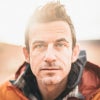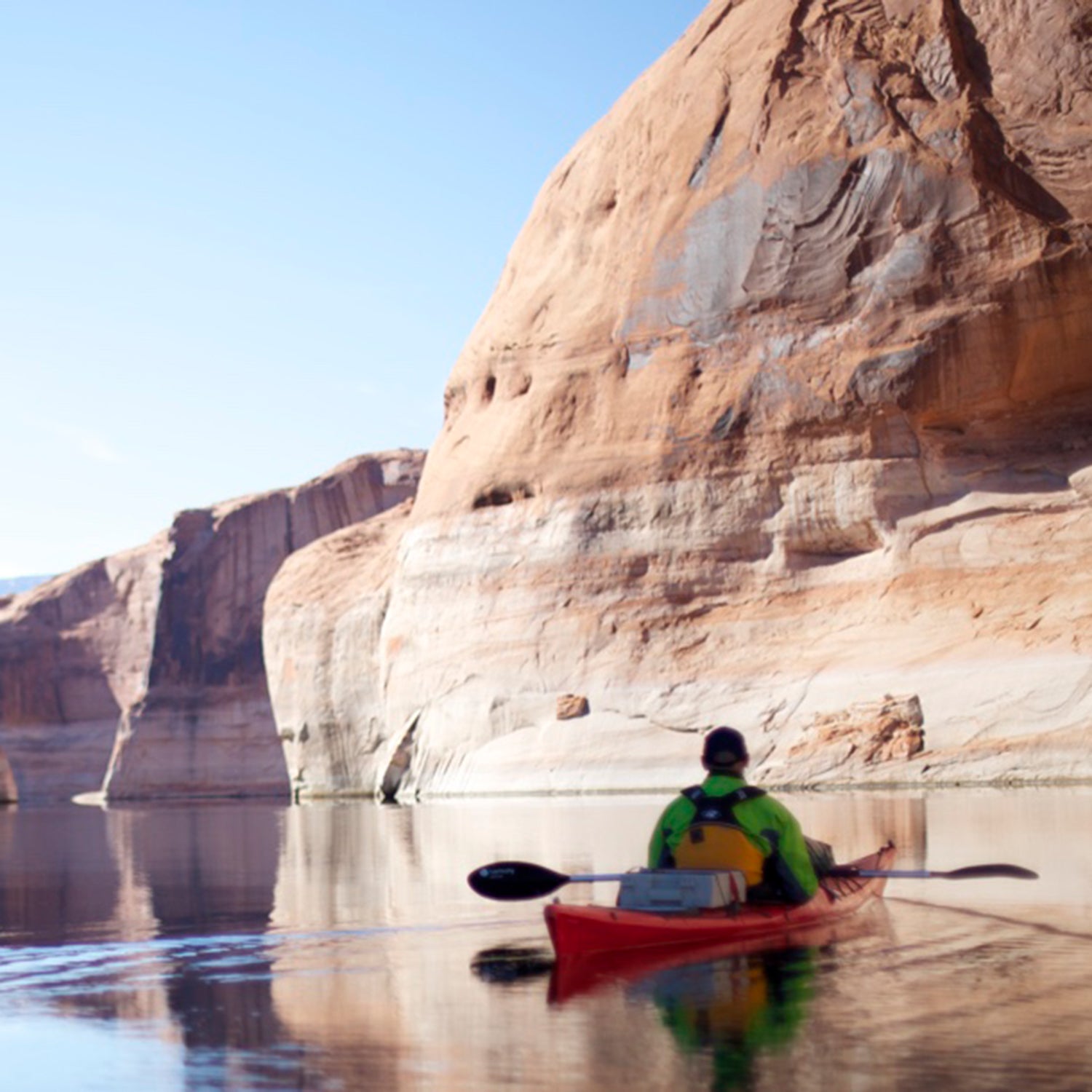Note: 2020 is the tenth year of my blog at , and since I started it, I’ve been fortunate to get to do some pretty wonderful adventures. Throughout this year, I’ve been writing about favorite adventures I’ve had since I started writing about the outdoors, one per month. This is the tenth in the 12-part series. The other stories are .
We all stopped speaking as our kayaks coasted between sheer sandstone walls 200 feet high, through the inky slack water that buried what used to be Clear Creek. The creek is a tributary of the Escalante River, which is a tributary of the Colorado River, which started to become a lake in 1963, which is why we made this trip: to see what’s still left of Glen Canyon, a place conservationists and desert rats have mourned the loss of since the Glen Canyon Dam created a reservoir on top of it.Â
We were looking for the most famous place in Glen Canyon, the Cathedral in the Desert, perhaps the most lamented of all the buried features. We reached it on day three of our eight-day trip from Hall’s Crossing, at river mile 93, to Antelope Marina, at river mile 6. I was near the front of the group, which included my friend Sinjin, a river activist; Kalen, a skier who’d been falling in love with the desert for the past year; my girlfriend, Hilary, who’d been in love with the desert for a decade now; and Forest, a photographer who grew up whitewater kayaking in North Carolina. The trip was Sinjin’s idea, and though I didn’t know it at the moment, when we paddled into the Cathedral, he had tears streaming down his face.Â
The walls climbed to a parabolic ceiling about 150 feet above our heads, and what used to be the “floor” of the Cathedral was about 50 feet below the hull of our kayaks, by my best guess. Lake Powell was at almost exactly 50 percent capacity the week of our trip in early December 2015, the water level 3,605 feet. The floor of the Cathedral is exposed when the lake’s water level recedes to 3,555 feet, which it briefly did in 2004 and 2005. If we’re lucky (or unlucky, depending on who you ask), I will be able to see the floor of the Cathedral again in my lifetime. Which also might be the next time I see my sunglasses.
“Can you paddle around a bit?” Forest called over to me from his boat. As far as action-sports-modeling gigs go, paddling a 17-foot sea kayak was definitely in my wheelhouse. So I paddled in a few circles. Along the north wall. Along the south wall. And then, to ham it up a bit for the camera, I figured I’d crane my neck back to look up at the sandstone walls, all the way to where they almost come together at the top, leaving a polygon-shaped hole filled with blue sky.Â
And that’s when my sunglasses slipped off my head and fell back, glancing off my boat and plunking into the water. As soon as I felt them sliding, I simultaneously thought, Oh shit, and shot my left hand off the paddle behind me, hoping for a lucky catch, which of course missed. They didn’t even float for a second before they were gone, replacement value $240. And I never lose sunglasses, either. But I was looking at five more days of paddling under a sun bouncing off a lake in the desert, with nothing more than squinting to protect me from macular degeneration. As I mentally cataloged the locations of the two pairs of Chums I had at home, and chastised myself for not bringing them on a flatwater kayak trip, I didn’t know Lake Powell would deliver a strikingly appropriate metaphor in a couple days. So I was just a little mad at myself and further confused by this place that I was supposed to passionately dislike.Â
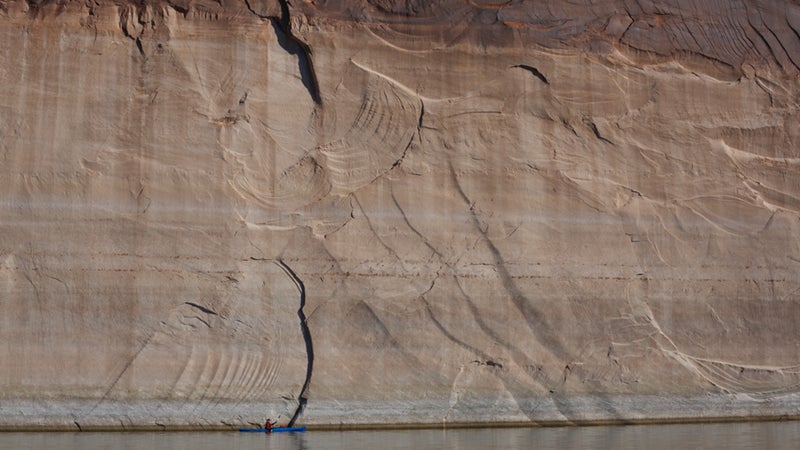
The week before we drove from Denver to Page, Arizona, to start our trip, Hilary and I met with our mortgage adviser, Lou, in an office park in the suburbs. We felt out of place in the meeting, two dirtbag writers who had only recently moved back into an apartment after living full-time in our van for a couple years, now trying to get a house loan. In discussing the home loan and the timeline for our first house purchase, Lou asked about our trip and how long we’d be out of cell-phone range. He had been on a houseboat trip on Lake Powell once, and he asked, “Have you ever just laid on your back out there in the desert and looked up at all those stars?” I remembered the nights sleeping on a Paco pad in the Grand Canyon, the air outside my sleeping bag a chilly 40 degrees, the Colorado River rushing by. I smiled and said yes and assumed his experience out there was pretty different.
Most people who have experienced the Colorado River in Glen Canyon in the past three and a half decades have done it in a motorized boat and called the river Lake Powell, as it’s marked on the maps for Glen Canyon National Recreation Area. Glen Canyon Dam was completed in 1963, and the lake reached what’s called “full pool” in 1980. Prior to our trip, I had never considered Lake Powell as a venue for any sort of recreation, because I usually spend my time in the outdoors doing human-powered activities, and when you bury a river under a reservoir, it becomes a haven for motorized boats. On the downriver side of Glen Canyon Dam is the granddaddy of all raft trips in the United States: the Colorado River through the Grand Canyon. On this side it’s a lake, more famous for spring-break trips, Jet Skis, and two-story houseboats with water slides built onto their second levels. I don’t think it’s too bold to hypothesize that if you prefer to paddle your boats, you very likely don’t believe in Lake Powell as a vacation destination—but if you own a houseboat, you probably think it’s the greatest place ever.Â
On our first day, we crammed our gear and food for eight days into drybags, stuffed them into the hatches of our kayaks, and pushed the boats in off the 80-foot-wide boat-launch ramp at Hall’s Crossing. We paddled across night-black water, glassy and gently lapping against steep sandstone walls and the bottom of the “bathtub ring,” a veneer of bleached algae and calcium carbonate covering the bottom 20 to 40 feet of the walls everywhere we looked. We headed down what we assumed was the middle, passing the buoys marking each river mile, alternating red and green. Our plan was to paddle 87 miles in eight days. We crossed our fingers that we wouldn’t run into any headwinds.
On day one, we paddled ten miles before stopping just before sunset at a camp in a small cove. My hands hurt from gripping the paddle, my shoulders hurt from pulling and pushing, and my back was stiff from a full day of sitting in a kayak. Since putting in, we hadn’t seen a single other human being, which wasn’t surprising given the outside temperature. A few minutes after pulling my boat onto the shore, the sun dipped below the horizon, and I put on all the layers of clothing I had in my boat, including a down jacket. It was cold. No one made it long after dinner before retiring to their sleeping bags for almost 12 hours.Â
We fell into a rhythm: wake up at late dawn (but not leave our sleeping bags until the sun was nearly on us), eat, pack boats, paddle ten or more miles, and pull into camp at 4 P.M. for the last hour of daylight before dusk. Unpack boats, set up camp, filter water, cook dinner, eat, and get back into sleeping bags by 8 or 8:30.Â
We only talked to two other human beings the entire trip, on our seventh day. On day five we tried to paddle to Dangling Rope Marina in hopes the store there would be open and have ice cream sandwiches—I had checked the website and didn’t see any note saying that it’d be closed. We paddled into the wind to get there, only to find it shuttered for the season. Somehow we all missed a sign, when we drove the shuttle car to Antelope Point, that clearly said it was closed until March 1. There was room to dock dozens of boats, and there were several gas pumps, a ranger station, a store, and no road access save a short, steep, narrow track of asphalt that apparently led to an airstrip above the marina. It was perhaps a bit foolish to hope the marina would be open, with the rest of Lake Powell a ghost town. Pro tip: if you want a huge lake to yourself, kayak across it in December.Â
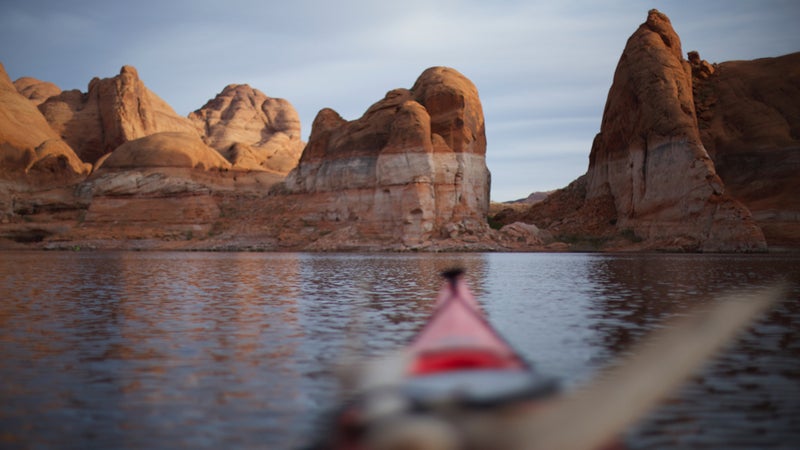
Paddling next to Sinjin, I finally admitted that although every grain of my Ed Abbey–informed sense of ethics despised it, the trip was kind of cool, in some sort of post-environmental apocalypse way. Every day we paddled a ton of miles, past beautiful (albeit half-submerged) desert terrain, camped where we wanted, and ate lots of calories. Even Forest said the trip had turned out to be way more fun than he expected. Was it OK for us to actually enjoy this in some way, I wondered, even though it was a shadow of its former, wild self?Â
“I think the problem is, a lot of river people are never going to come here,” Sinjin said. “Because that would be admitting that this place has something to offer—including being an example of something we should never do again.”
Sinjin is the third generation of his family to fight to keep the Colorado River wild, before and after Glen Canyon Dam. He works for , an organization whose official position is not to immediately get rid of the dam or Lake Powell. The reservoir, and the dam, are so integrated in the complicated plan of how water is managed in the Southwest that blowing it up (as plenty of environmentalists and river runners have no doubt fantasized about) would explode the entire region’s water policy. Long before Glen Canyon Dam was built, in 1922, seven states (Colorado, Wyoming, Utah, New Mexico, Arizona, Nevada, and California) created the water policy for the Southwest, not realizing the data they were using to divide up the waters of the Colorado River came from an extremely wet period in the river’s history. So they overestimated how much water the river could provide and overpromised it. The dam now divides the Upper Basin of the Colorado from the Lower Basin. And American Rivers says that although a wild Colorado River flowing through Glen Canyon would be wonderful, getting rid of the dam is not sustainable right now.Â
“One day we would love to see Lake Powell decommissioned and the Colorado River restored through Glen Canyon, but it’s not a viable option at this time,” Matt Rice, director of American Rivers’ Colorado Basin Program, said. “Powell plays an important role in the basin—it stores water for upstream states to ensure compact compliance and Lower Basin deliveries. It produces hydropower for millions of people, which pays for important conservation programs to restore endangered fish species and improve water quality for fish wildlife and agriculture, and it remains an important recreational resource for millions of Americans.”
Rice said strategic conservation measures could make decommissioning Glen Canyon Dam in a decade or two possible—or climate change could deplete the reservoir to the point where it won’t be able to generate hydropower.Â
Sinjin, of course, sitting in the middle of the lake, had a more succinct, impassioned answer: “At the first opportunity we have to take it out sustainably, [expletive deleted] blow it up.”Â
Eric Balken of the represents the other side of the conservation movement, which wants to restore Glen Canyon by eliminating what’s seen as a wasteful reservoir that loses 123 million gallons to seepage into the porous rock underneath each year, and another 168 million gallons that evaporate off the surface of the lake annually. Balken said they don’t necessarily want or need to remove the dam, although they wouldn’t complain if that went away, too. They just want Glen Canyon back.
“Our mission is to fill Lake Mead first,” Balken said of the man-made reservoir downstream from Lake Powell on the outskirts of Las Vegas. “We advocate water storage in Lake Mead instead of Lake Powell, which would actually save water, according to a study that was completed in 2013. The amount of water that’s lost to seepage in Lake Powell is so great that just by storing water in Lake Mead instead, you’d have a savings of 300,000 acre-feet—which is the same amount of water that the entire state of Nevada gets from the river each year.”Â
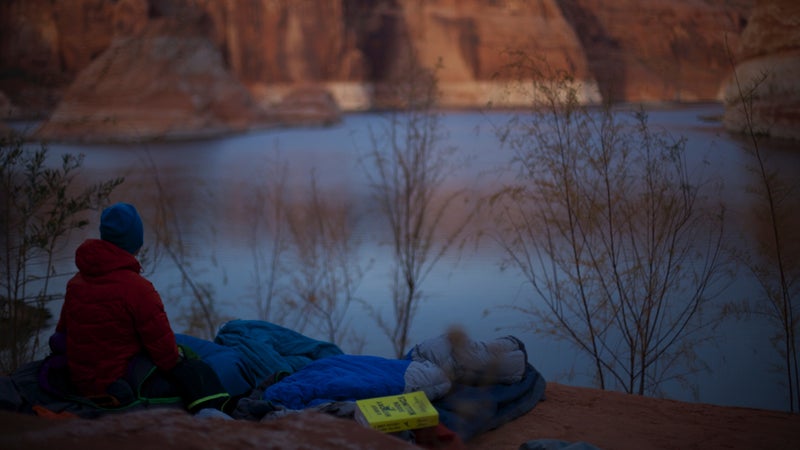
Lake Powell is a paradise of rock, above the water and no doubt below. I sat in the middle of an almost mile-wide spot in the lake one morning, slowly spinning my boat around to take in the 360 degrees of desert views: rounded burnt-red sandstone walls dripping with dark streaks of desert varnish; black patches and ghost-white sections where a chunk of sandstone cleaved off a thousand years ago, or last week; some fallen blocks the size of cars, some the size of buses, one the size of a tennis court; alcoves just starting to form by erosion or large enough to hold Anasazi ruins; plates of sandstone that have peeled off their ever eroding ceilings piled broken on the floor; a ring of bushes and green vegetation 60 feet above the water line, a 50-foot-tall bathtub ring below that, and then me, out in the middle, wondering how many Canyonlands National Parks were 250 feet below my kayak.Â
The next morning, the sun sneaked out behind a hazy cloud and illuminated the water around Hilary and me just deep enough to see a school-bus-size boulder appear under the water between us and a rock wall. We were paddling hard, and I warned Hilary about the rock, imagining it sneaking up underneath her boat with just enough angle to flip her into the water. Nobody wants to have to climb back into a kayak out of 45-degree water and try to dry off in partly cloudy 45-degree air. Later we’d paddle over the tops of barely submerged pinnacles in the middle of the water, with maybe only a foot and a half of lake water covering them. How did people drive houseboats through here and not tear them open on these things?Â
I started to make peace with the reservoir. It’s not going away anytime soon, so I might as well enjoy it in some way. How many lakes in the U.S. can you paddle across for eight days and hardly see another human? I tried to make a sort of emotional truce with the place, taking photos and having fun with my friends, even if I was scratching my head at the whole thing.Â
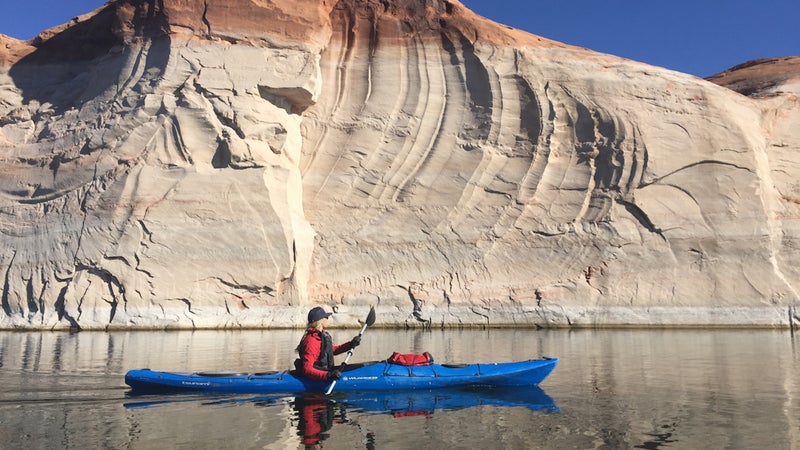
On day six, I got the idea that it would be cool to see Grotto Canyon, the site of a famous photo of river activist and musician Katie Lee—the one where she’s wearing a bikini, not the one where she climbed up into a slot canyon naked (a framed version of which Hilary had hung in our apartment). Maybe we’d just be able to see that spot?Â
I paddled into the canyon between a 30-foot-wide slot in the sweeping walls. The canyon closed down to where I could scarcely take a stroke without scraping my paddle on the walls, and the water beneath me cleared to where I could see the shallow bottom. One, two, three 16-inch carp appeared out of the back of the canyon and swam beneath me so close I probably could have tapped one with my paddle.Â
“I think we’re on top of your grotto,” Sinjin said from behind me. At the back, the walls narrow to a point and, I imagine, during rainy days a curving waterfall streaks down the notch. I couldn’t turn my boat around—if I held my paddle perpendicular to the walls, both ends touched rock. A tiny stream of bubbles rolled out of an invisible hole in the flat floor six feet below my boat. I took my paddle and pushed it down, the blade hitting the bottom. Silt. Soft. The canyon is buried under water, and under the water, it and dozens like it are buried under silt that’s gathered above the dam. I imagine beer cans, boat parts, deck chairs, Mardi Gras beads, the occasional busted flip-flop down there as well, the detritus of a river made into a lake, which thusly loses its self-cleaning mechanism. Oh, and my $240 sunglasses.Â
With two days left, and two and a half days of paddling without sun protection over my eyes, I pulled my kayak onto the beach at our campsite. I turned to my left, and six feet past the bow was a pair of sunglasses, sitting in the sand, with dirt crusted over the lenses. I picked them up, rinsed them in the lake, and gave them a look: black with neon-yellow, scratched lenses, the logo from a casino, the Reserve at Star Pass, on the temple. Crappy, gaudy, easy, one of those things you get “for free” but really you paid hundreds or thousands of dollars to someone before you got them for free.Â
The whole trip, I had been searching for metaphors for the Glen Canyon turned Lake Powell. It was like a Yankee Stadium buried and replaced with a new Yankee Stadium. (To which Hilary said, “Yeah, a smaller, shittier Yankee Stadium.”) It was like driving around your dad’s hometown with him and listening to him tell stories about a pool hall where he’d spent his formative years and then finding a KFC where the pool hall used to be. It was like those things, yes, but it was probably most like losing a really nice pair of expensive sunglasses with unscratched (and polarized!) lenses, and a couple days later, finding some scratched, old, semi-nasty casino sunglasses in the dirt, putting them on your face, and saying, “Well, they’re good enough for now.”Â
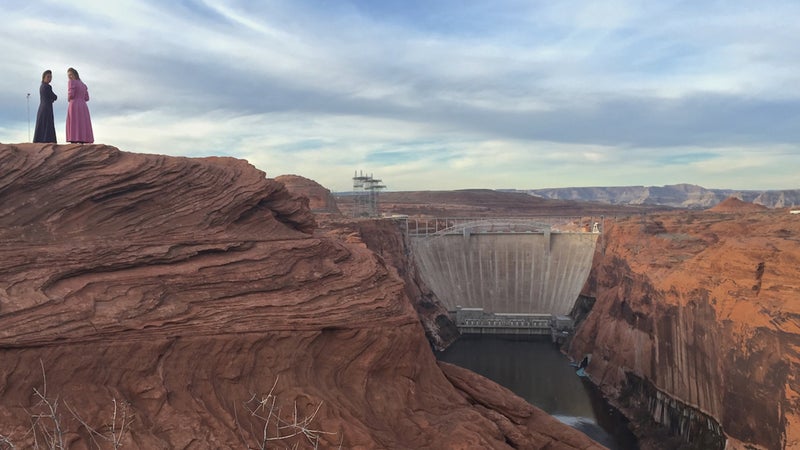
I woke up at 3 A.M. to the dreaded reality that I had to pee and I’d have to leave my warm sleeping bag to stand outside in the 35-degree air for a minute or so before crawling back in. Hilary and I had cozied our bivy sacks into a niche in the top of a sandstone dome, and I was only halfway through the night with another five cold hours to go before the sun came up. The moon had just popped up over the eastern horizon, barely peeking out. If I bent my knees and squatted slightly, I could make it disappear behind the curve of the earth. Sometime in the night, the lake had begun lapping at the steep walls of the cove beneath us, loudly swishing around our campsite, surrounded by water 50 feet below down the sloping rock walls.Â
I slid back into my bivy sack, a slight breeze wafting cold air into my sleeping bag through the opening at my face. I laid there on my back on that big rock and looked up at the stars, just like Lou, our mortgage adviser, had done from the deck of a houseboat sometime when it was warmer and much busier here. Between when I went to sleep and now, Orion had rolled from the eastern horizon, over my left shoulder, all the way to the western horizon, over my feet, and a shooting star tracked across the dark bowl of sky. What a confusing place.Â
A version of this story appeared in Canoe and Kayak magazine (RIP) in 2016.

